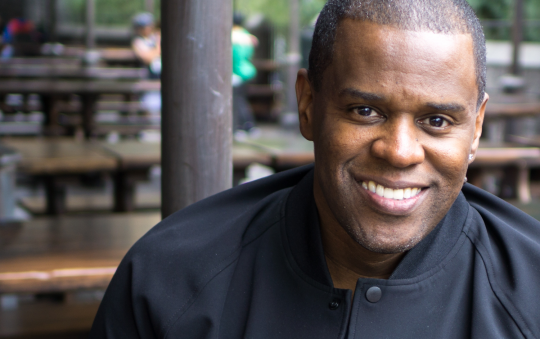Television and radio personality Rolonda Watts will join other celebrities and community activists Sunday, November 18, at the 11th annual Coalition for At Risk Restoring Youth (CARRY) “Wind Beneath my Wings” benefit. Awardees at the event will include actress Yara Shahidi (“Black-ish,” “Grown-ish”), Dr. William Burke and former County Supervisor, Yvonne Brathwaite Burke. Watts is hosting the benefit, where proceeds will be going to CARRY, an organization for at-risk and foster youth.
“We don’t lead by titles, we lead by example,” said Watts.
“And CARRY is a great example [of community activism].”
Celebrity dermatologist Pearl Grimes founded CARRY, to help foster and at-risk youth with things like developing social skills and taking advantage of scholarship programs. She also provides free dermatology services for them. The organization’s mission, said its officials, is to make a difference in the lives of these children by helping them to develop an sense of self-esteem, self-worth, self-sufficiency and so that they can enjoy long term success.
“I’m a big fan of Dr. Grimes, and I love the work that she does with the youth,” said Watts.
“She not only deals with layers of skin, she is dealing with the layers of these kids’ lives. I’m just hosting the show, but my heart is really with these children. The time to shine for our children is now…”
And shine they will. Over 300 of Southern California’s most influential and socially conscious supporters will be there, said organizers. Celebrated Adam Aejay’e Jackson & Friends Jazz Ensemble will serve as entertainment. Two dozen celebrities including Yara Shahidi (“Black-ish”), Vivica A. Fox, (“Independence Day”), Tilda Del Toro (“Night School”), Michael Einzegir (“Incubus”), Donnell Turner (“General Hospital”), Kate Linder (“Young & the Restless”), Tasha Smith (“Empire”), Skyler Bible (“First Man”), Paige Mobley (“America’s Next Top Model”), Laura Goven (“Basketball Wives”), Veronika Obeng (“Second Wives Club”), Jason Moore (“The Punisher”), Kim Estes (Emmy-winner), Brianna Barnes (“Nocturnal Animals”), casts of “The People v. OJ Simpson,” “American Horror Story,” are confirmed to attend. Sponsors include Princess Cruises, Diamond Veneer Jewelry, Davigna Wines, Adriano Hair Salon, Unplug Meditation and Harper Collins Books.
The 11th annual C.A.R.R.Y. Gala’s jazz brunch will celebrate the organization’s decade of service to at-risk youth in the greater Los Angeles area, said Grimes, who also serves as the event chair.
“We cherish our youth and the difference we make together to impact the lives of the underserved and neglected population who, with CARRY’s love and support, can fulfill their potential,” she said.
“Resilience, compassion and the spirit of ‘giving’ to children who need a helping hand most is what heroes are made of.”
At-risk youth comprise a vast population of young people often residing in urban areas of the United States, Grimes said.
“Such youth have been described as being economically and socially disenfranchised and are generally defined as, by virtue of their circumstances, statistically more likely than others to fail. They often live in chronic poverty with negative peer influences, and possibly live in foster care. When the needs of these young people go unmet, their potential negative outcomes include: teenage pregnancy, criminal or antisocial behavior, poor academic performance, shorter life span, mental health problems, and unhealthy relationships…”
According to CARRY, In 2007, nearly 40 percent of children in the United States lived in low-income families — families with incomes at or below 200 percent of the federal poverty level (United States Bureau of the Census, 2008). When not given positive resources and opportunities, youth from low-income families are vulnerable to poor outcomes as adults. Some key points from the 2008 Social and Economic Supplement of the United States Bureau of the Census suggest:
- Youth from low-income families engage in more risk behaviors during adolescence than youth from middle-income and high-income families.
- Youth from low-income families are more likely than youth from middle- and high-income families to have sex before age 16, become a member of a gang, attack someone or get into a fight, steal something worth more than 50 dollars, and ever run away. However, youth from low-income families are not more likely than youth from middle- and high-income families to use alcohol and marijuana, sell illegal drugs, or destroy property.
- Seven percent of young women from low-income families have a child by age 18, while only 2 percent of females from middle-income families and 1 percent of females from high-income families have a birth by this age.
- Nearly a third of youth from low-income families (29 percent) fail to earn high school diplomas, approximately three times greater than the percentage of youth from middle-income families (ten percent) and roughly six times greater than the percentage of youth from high-income families (five percent).
- Only one in ten youth from low-income families (ten percent) go on to graduate from a four-year college, compared with over a quarter (28 percent) of youth from middle-income families and half (50 percent) of youth from high-income families.
- One in five youth from low-income families (20 percent) are charged with an adult crime by the age of 24, which is higher than the number of youth from middle- and high-income families (16 and 12 percent, respectively).
- Less than half of youth from low-income families (44 percent) remain consistently-connected to school and/or the labor market between ages 18 and 24, a lower share than among youth from middle- and high-income families (67 and 75 percent, respectively)
- Roughly one in five youth from low-income families (18 percent) never connect (making extremely short, or no connections to school and/or the labor market between ages 18 and 24), while only one in 50 youth from high-income families (two percent) fall into this category.
For more information visit foratriskyouth.org.







